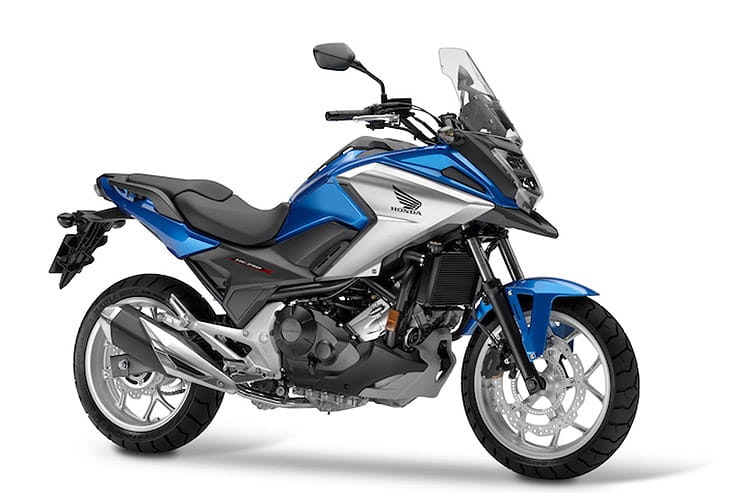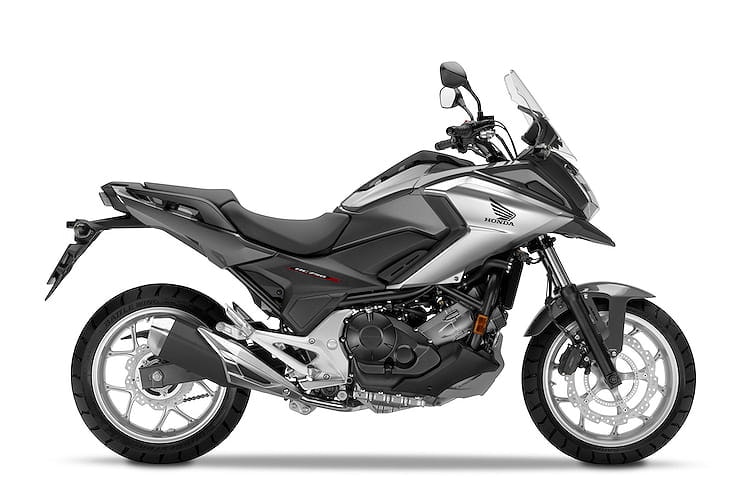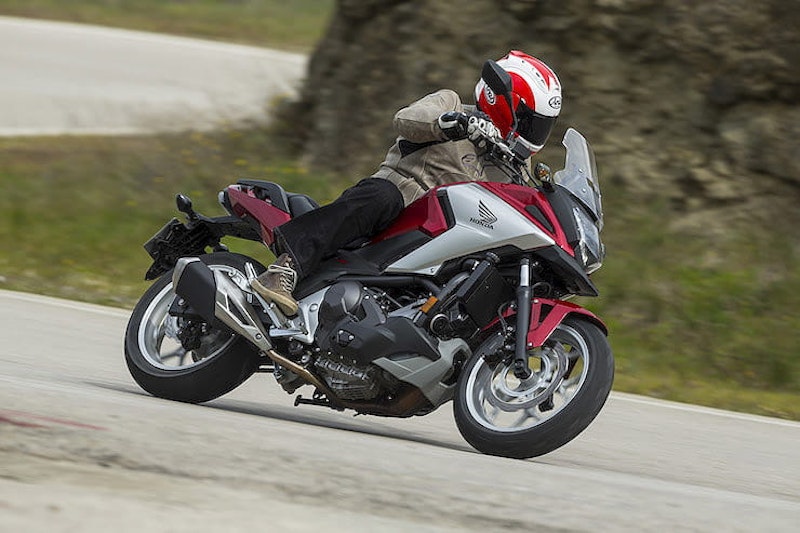Honda NC750X (2016-on): Review & Buying Guide
By Phil West
Freelance journalist/editor/author
16.10.2020
Honda’s uber-practical, mid-capacity, super frugal mini adventure-tourer, the NC750X, was treated to a grown-up and Euro 4 compliant facelift for 2016 and came with some smart new technology tweaks, too.
Since its launch in 2012, as the NC700, it hasn’t been the super sexy, poster bike that adorns teenagers’ bedroom walls but the Japanese firm sold 33,000 of them up to 2016 and it was Honda’s best-selling ‘big motorcycle’ in Europe in 2015.
The bike’s popularity stems from having a handy combination of decent performance, particularly mid-range torque, and its quirky storage solution where the traditional area reserved for a fuel tank is replaced with a large and lockable void. Add into the mix reliability; build quality, ease to ride and mega economy – with figures of 80+mpg on the cards with a tank range in excess of 250 miles from the 14.1 litre tank. Oh, and it comes with quite an attractive price point, too.
It was enlarged to 750cc in 2014 then, for 2016 it gained: a much more modern and grown-up look similar to its adventure-esque siblings such as the incredible new-generation Africa Twin; revised suspension and brakes; new LCD dash; aforementioned updated engine; revised DCT automatic transmission option and other detail changes. In 2018 it also received a further mild update gaining Honda’s latest traction control system (HSTC) plus other minor tweaks such as a 900rpm higher rev limit and small styling adjustments.
Honda NC750X (2016-on): Price
All these updates also saw the price rise from just over £6000 for the non-DCT version to £6649 plus a further £400 required for the DCT version. Even so, the NC750X remains good value for money, is currently offered on a tempting PCP deal and is extremely cheap to run. Its popularity, durability and typical Honda quality also makes it an in-demand used buy, which helps keep used prices high. Even the cheapest, shabbiest, highest mileage 2016 example still commands prices of over £4000 with good, virtually new low-milers offering over minimal savings over new.
Power and Torque
I wouldn’t usually describe a motorcycle’s performance as Sensual, and the NC750X’s is nowhere near scary but that’s not the idea or design intention of Honda’s entry-level adventure bike. The throb of the 270-degree crankshaft is hearty and strong, similar to a V-twin in a way and gives reassurance of the build quality one expects from Honda.
Throttle response on the DCT-equipped bikes that we were afforded at the press launch in Malaga, Spain, isn’t the sharpest. Off the line the bike is certainly smooth with as much or as little throttle applied as required.
However, it is a little sluggish. 54bhp from a bike weighing 238kg (more than an Africa Twin by the way) isn’t going to blow your socks off and hauling the thing away from the lights feels like a struggle to climb the first few revs quickly. However, the wait to test the NC750X’s mid-range performance in the faster, flowing mountain sections of our test ride was worth it. The bike reacts well when the throttle is pinned for an overtake for example, dropping a gear or two depending on the auto’ mode selected.
Engine, Gearbox and Exhaust
In 2014 the original NC gained an extra 6 horsepower and capacity was increased to 745cc. This time around, Honda hasn’t worried about amending the liquid-cooled, parallel twin power plant and its 54bhp at 6250rpm. There’s also a lighter, Euro 4 compliant side-sweeping muffler, which sounds much better than before.
Instead, most of the news is about Honda’s clever, semi-automatic, ‘DCT’ (Dual Clutch Transmission) option.
As before you can prod the NC into fully automatic D (Drive) or S (Sport) modes, or you can manually switch up and down through the gears via the ‘+’ and ‘-‘ button on the left (clutch lever-less) bar. What’s new is a new three level S-mode designed to offer the rider more flexibility whether riding in town or blasting around country lanes.
D, mode is pleasant enough for pottering around town and is, of course, the most fuel-efficient way to maximise those miles per gallon. The revs are kept low, as is the exhaust note. No clutch lever takes a little getting used to and if you’ve never experienced one of the very few bikes around without one, you could well be prone to an occasional ‘ghost grab’! To be honest, this should be such a minor concern because the NC750X is a doddle to ride and easy to get used to despite the DCT and its modes.
However the 2016 improvements are certainly noticeable, now being a much smoother ‘box as the dual clutches engage gears 1, 3, 5 and 2, 4, 6 independently. There’s also no pitching of the chassis on its suspension between gear changes and no need to roll off the throttle either – either let the bike do its thing or change up and down manually. Silky.
That said, the audible jump between 1st and 2nd gear both up and down at very low speed is just about noticeable and ever so slightly ungraceful. You can hear the clunk more than feel it yet it still counts as a mark against the DCT from being declared a super-modern and slick bit of kit. Aside from this minor niggle, the system is so good that the mechanical change of gears higher in the rev range, under hard acceleration for example, is so efficient that it’s barely noticeable. So many modern car automatic boxes are similar, maximising mpgs and offering a smooth drive.
The gearbox can be over-ridden and even in the sportiest, S3, setting of the updated DCT. I’d occasionally knock it down to second gear with a quick flick of a button on the underside of the left handlebar that would ensure a more enthusiastic exit to a corner, which the bike preferred to take in third. By leaving it third the bike doesn’t have enough steam to drive out of the corner. This isn’t a criticism; it’s just how I prefer to ride.
For me, there isn’t enough difference between the three ‘S’ modes as there could have been. If there are going to be the quantity of rider-controlled options, then the difference should be greater. A ‘D’ mode and two S modes would be ample. Even an off-road mode for those keen to test their gravel-related ability wouldn’t have gone amiss, particularly as the NC750 has an ‘X’ designation in its name referring to its adventure prowess. During the short time we tested the bike on a dusty, gravely track I simply flicked the button to engage manual mode and stuck with second gear. It meant I could guarantee the bike wouldn’t be hunting for a gear while I concentrated on testing the suspension and grip levels away from the tarmac.
Honda NC750X (2016-on): Economy
Despite the engine and gearbox changes there’s little different here. The hugely frugal, low revving, Honda Jazz car-derived parallel twin has always delivered big mpgs and Honda still claim over 80 for this latest version, making over 250 miles from its 14.1 litre under seat fuel tank within reach.
Handling, suspension, chassis and weight
Suspension mods were also among the changes for 2016. The 41mm front forks are now equipped with Showa’s ‘dual bending valves’, which essentially improve oil flow through the suspension. While at the rear, the monoshock is now adjustable through 7 settings for preload, ideal if you’re carrying luggage or a pillion.
In addition, the engine remains housed in a low position in the frame while the fuel tank is under the seat, both giving the bike a lower centre of gravity, handy for stability, agility and cornering. The result is that this smart-looking bike is also a smart-handler, too, and good fun to ride, responding well if momentum is maintained.
Even though the DCT version weighs 230kg (versus the 220kg of the manual version), it’s so well balanced it hardly feels hefty either at low or high speed. There’s a positive feel through the raised bars connected to a Dunlop Trailmax D609 via the new Showa forks. Darting between 2nd and 3rd gear left and right-handers coming down the mountain road back towards Malaga at a healthy rate of knots was a good tester for the Honda’s agility. Overall, I was impressed with the NC’s ability.
Honda NC750X (2016-on): Brakes
Being an automatic, the engine braking is compromised and therefore you’d rely a little more on the brakes. These are ABS-assisted as is standard these days but the single front 320mm wavy disc, although new, is not as good as it should be. The lever is adjustable and if you pull as hard as you dare there’s about enough to scrub off speed, but it’s not as sharp as it could be while, at the rear, the ABS is a little too keen to step in. In fact, I used the rear more than I would on a regular bike, just to settle it a little and to offer more reassurance when the brakes were put under exaggerated stress.
Comfort over distance and touring
Along with the restyle there’s an effective new screen which also feels sturdy and well-attached, not flimsy and flexible like some, although it isn’t adjustable.
On top of that you get a sense of comfort on the NC750X straight away. A narrow-ish waist at the front of the seat makes the 830mm height accessible for shorter riders, while the footpegs are positioned high enough not to concern anyone other than Mr Marquez about scraping the hero blobs. It also means the riding position and relationship between the raised handlebar, seat and pegs plus the comfort of the seat, quality of the suspension and new screen makes the NC750X a very good motorcycle to put the miles in without needing to stretch. In theory the tank range should be good enough for 250 miles and I reckon you could manage that in one sitting. Now, there’s a challenge.
Rider aids and extra equipment / accessories
Although still a little on the basic, budget side, the 2016 version of the NC750X is a significant update over the old and does feature a few neat touches.
The bigger and brighter new LCD dashboard comes with an array of rev range related colours – looking like the kind of lighting used at your school disco back in the day. Honda say it’s supposed to “keep you informed of the bike's performance with the use of intuitive colour-coded lights” but you’ll do well to remember what each colour means let alone relying on them to remind you of how fast you’re going! Pretty though.
Storage-wise, the existing and novel fuel tank located space is now up 1 litre to 22 litres, comfortably large enough to hold a full-face Arai RX-7V, and conveniently it’s lockable.
While, being an automatic, meaning you can’t leave it parked on an incline in first gear as you might do normally, Honda have retained a handlebar- mounted parking brake. It’s simple to use; just pull the lever back like a handbrake in a car then when the time comes to take it off, take the slack and press the button to release.
That, however, is it, with no riding modes etc. although Honda’s basic form of traction control – HSTC – was added in 2018.
Official accessories, meanwhile, include heated grips, an Akropovič exhaust, top box and panniers.
Honda NC750X (2016-on): verdict
The 2016 NC750X contains some really effective upgrades: its striking looks are much more refined and better than the outgoing model; the adventure styling really suits the NC giving a better identity and the DCT gearbox has moved on remarkably well. It makes a damn good commuter given its filtering ability, comfort and economy, is ridiculously easy to ride, especially in DCT form, is economical and cheap to run and good value, too. No wonder it remains so popular.
Three things we love about the NC750X…
Brilliant mpg figures on top of cheap price
Easy, effective manners, especially with DCT
Clever design touches and improved style
Three things that we don’t…
Slightly underwhelming performance
Brakes are a little weak
Fairly basic spec
Honda NC750X (2016-on): spec
Looking for motorcycle insurance? Get a quote for this motorbike with Bennetts bike insurance



